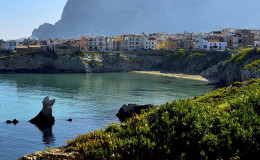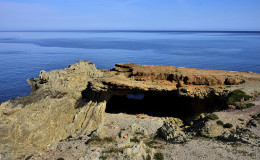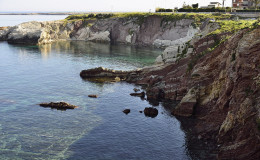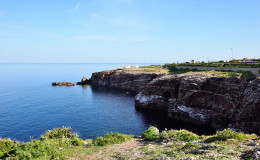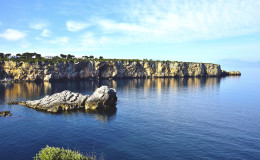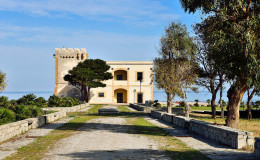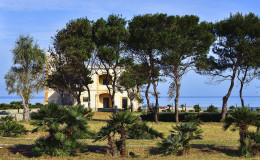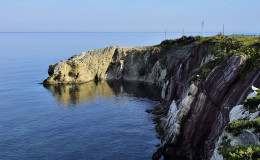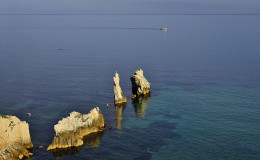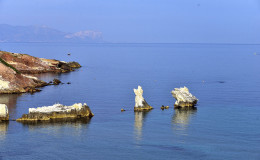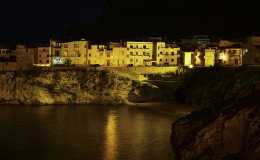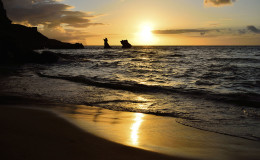For more information about Terrasini go to the website
Terrasini is located 30 km from Palermo towards Trapani, next to the airport Falcone-Borsellino Airport, overlooking the Gulf of Castellammare.
The coast of Terrasini, which stretches from the beach Ciucca up to another beach, San Cataldo, is of mixed type, alternating with rocky coves and steep cliffs high over the sea.
Terrasini is located near the Nature Reserve Cape Rama, established by the Region of Sicily in June 2000 and entrusted to the management of the WWF Italy.
The name Terrasini, according to the historian Joachim Di Marzo, derives from Cape Rama, who with the opposite Capo San Vito gives rise to the Gulf of Castellammare, the old “sinus aegestanus.” The territory then began to be called the sinus floor, floor of the gulf. Another interpretation, perhaps more appropriate, derives from Terrasini Sinorum land, “land of the Creeks”, the sinuous and jagged coast, rich in harbors, natural caves, which starts from the shore of Ciucca in the Gulf of Terrasini, you up to thirty or more meters from the sea level and ends at a sandy beach: the beach of San Cataldo.
The center of town is the Piazza Duomo, large rectangular space planning, against the backdrop of the majestic cathedral dedicated to Our Lady of Grace, the patron saint of terrasinesi.
The Cataldi Palace, the Municipal Library “Claudio Catalfio”, in Benedict Saputo, and the eighteenth-century castle of the princes La Grua Talamanca, today the town hall in Piazza Borsellino and Falcone, today remodeled building. At the center of the square, located in front of the palace La Grua is the War Memorial, a gift of Terrasinesi residents in Detroit, depicting a stone quadrangular marble engraved with the names of the fallen terrasinesi in the two great wars of the last century. The memorial is surmounted by a winged figure, probably a kind of Nike, goddess of victory, holding a laurel wreath.
The palace D’Aumale from 1984 is home to the museum, the museum was born from the union of the historical-ethnographic museum of Sicilian cart “S. Ventimiglia” which was founded in 1973 through the efforts of Professor Salvatore Ventimiglia with the Civic Museum Natural History that had been opened in 1981.
The museum consists of three different thematic areas, ethnographic, the naturalistic and the archaeological site. Originally, the museum kept, in addition to the collection etnogragica Salvatore Ventimiglia, from natural history collections such as the ornithological collection Sommariva, the collection of mammals Orlando, both donated to the city, and the ornithological collection of properties in Orlando.
In the green suburbs, between patches of olive trees, lemon and orange trees, some buildings are worthy of mention. First of all, Villa Fassini, Art Nouveau attributed to the great architect Ernesto Basile. The villa, which belonged to the powerful Sicilian family Florio, was also a meeting place, in the 70s, of a large and important community ‘hippy, formed by young people from all over Italy and Europe.
In addition, in the district Bagliuso, are the seventeenth-century Gazzara castle, which belonged to the powerful local barony and the characteristic senia, instrument used for agricultural irrigation since the Arab period, the expression of local peasant culture.
The oldest artifact existing in the town of Terrasini is the Tower of Cape Rama overlooking the homonymous promontory, falling in Zone A of the Natural Reserve of Capo Rama.
The tower was built in the fifteenth century for spotting the pirate boats and signal their presence through the orphans and is included in all the official lists of the towers that made up the complex system of coastal lookout towers coast of Sicily.
Torre Alba
The ancient and majestic lookout towers (Alba Tower, Tower of Cape Rama, Tower Toleda or Paternella Tower, Tower of the San Cataldo), were used to warn the population of the village at the time of the attacks of fearsome pirates or even more dreaded Saracens . The sighting system, ingenious, provided for the placement of a tower at each strategic promontory of the territory, always maintaining the visual communication between a tower and the other, in such a way that, in case of emergency, the light signals from a the other tower were transmitted very quickly throughout the territory.
The tower of Capo Rama was part of the 11 towers controlled by the Senate of the City of Palermo, which also represented the westernmost.
Company
The feast of Our Lady of Grace is the party felt, is celebrated in September, the particular elements are the procession in which the statue is carried through the streets of the country at the end of which you are running the fireworks at the waterfront Impastato. Particularly investee is also the feast of St. Peter, in which you can witness the procession of the statue transported by boat to the party which is followed by the “frying pan” with tasting fresh fish and wine. In mid-March is celebrated the feast of St. Joseph characterized from the preparation of the famous “Canteens”.
The day of Easter in Terrasini uses an ancient tradition, “The Feast of Schietti “ the first evidence of the feast Schietti of them date back to around 1850 to 1860. By a committee composed of bachelors who cementing in the pull of a bitter orange (bitter orange) of approximately 50 kg.

